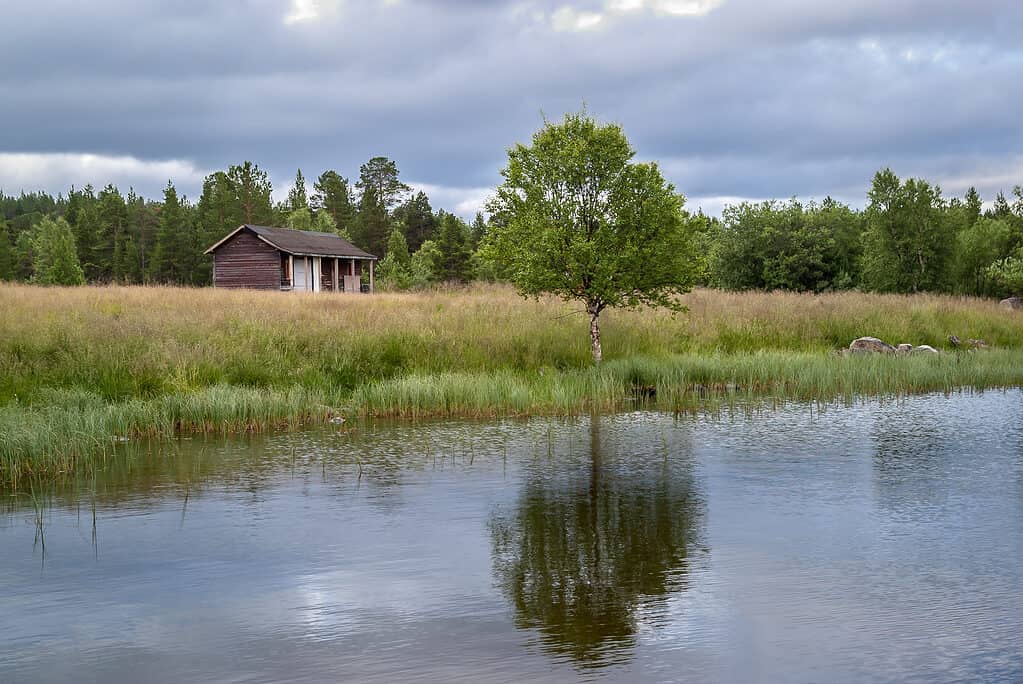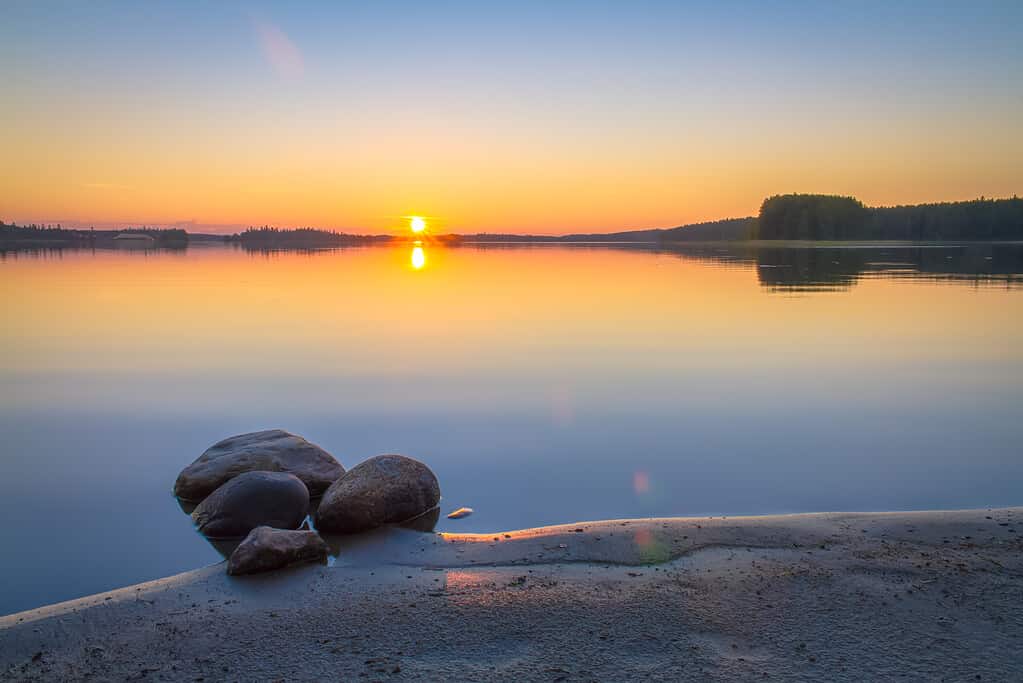In most places, the sun disappears far before midnight. However, the midnight sun is a phenomenon that appears in some places where the sun doesn’t disappear. Instead, it stays throughout the night. Find out where you can experience the midnight sun below.
That said, there are also only certain times when you can see the sun at midnight. It’s important to plan any potential trips with this in mind. We’ll also take a look at the necessary timing below.
Why Does the Midnight Sun Occur?

The midnight sun appears near the poles of the Earth.
©Kertu/Shutterstock.com
The midnight sun is a celestial event caused by the Earth’s axis tilt and its orbit around the sun. The Earth’s axial tilt is about 23.5 degrees. In other words, the Earth is not straight up and down when compared to the sun. As a result, during different times of the year, one hemisphere is tilted closer to the sun while the other is tilted away.
The midnight sun occurs in some areas because of this tilt. This occurs in high latitudes, near the poles. Locations within the Arctic Circle and Antarctic Circle are most well-known for experiencing this phenomenon.
During the summer solstice in the Northern Hemisphere, the North Pole is tilted directly toward the sun. As a result, the Arctic Circle experiences daylight for several continuous hours.
Conversely, during the Southern Hemisphere’s summer solstice, the South Pole tilts towards the sun. Therefore, the Antarctic Circle tends to experience the midnight sun, as well.
Where Can You Experience the Midnight Sun?

Finland’s Lapland region is a popular place to view the midnight sun.
©Plam Petrov/Shutterstock.com
Northern Hemisphere
To see the midnight sun in the northern hemispheres, you have to travel into or close to the Arctic Circle. The Nordic countries offer some of the most popular and accessible places to see the midnight sun. In Norway, places like Tromsø and the North Cape are famous for their stunning Midnight Sun views. Sweden’s Abisko National Park and Finland’s Lapland region are equally captivating destinations.
You can also see the midnight sun in some places in Alaska, including Fairbanks and Barrow. These provide a great option for those living in the United States.
Canada also provides several remote locations to witness the midnight sun. Places like Whitehorse in the Yukon and Inuvik in the Northwest Territories provide some of the best experiences.
Iceland also experiences the midnight sun. Reykjavik and Akureyri are the most popular options, but practically anywhere in Iceland works.
Russia also has some cities in Siberia that experience the midnight sun. Often, these areas are more rural than places in southern Russia, though.
Southern Hemisphere
While the Antarctic Peninsula is not as accessible as the Arctic Circle, there are a few places where you can witness the Midnight Sun. You often have to go on an expedition to Antarctica, which usually leaves from South America.
You can also view the midnight sun from the southern tip of South America. The further south you can get, the higher your chance of experiencing the midnight sun.
Best Times to See the Midnight Sun

The best time to see the midnight sun in Finland is between June and July.
©Ville Heikkinen/iStock via Getty Images
As we’ve discussed, timing is also important. Nowhere experiences the midnight sun all the time, so it is vital that you consider the timing of your trip. You must match up where you plan to go with your timing.
Northern Hemisphere
In the northern hemisphere, you should visit between late May to late June. The best time to go is June 21st, which is the summer solstice. The exact dates can vary slightly depending on your latitude and location, though.
In Norway and Sweden, the best times for viewing are from late May to mid-July. In Finland, the best times are from early June to early July. In Alaska, the Midnight Sun can be experienced from late May to mid-July, with variations depending on the specific location within the state.
In Canada, you can often see the midnight sun from late May to early July. Iceland experiences the Midnight Sun from late May to early August, providing an extended window for travelers to enjoy the continuous daylight.
Southern Hemisphere
The southern hemisphere experiences the midnight sun during their summer months, which occur while the northern hemisphere experiences winter. The peak for most viewing is on December 21st.
Often, expeditions typically provide a chance to view the midnight sun from late November to late December.
Challenges of the Midnight Sun

The phenomenon of the midnight sun can confuse your body’s circadian rhythm and disturb your sleep.
©Ellyy/Shutterstock.com
The Midnight Sun, while captivating, also offers plenty of challenges for those who live within its effects.
For instance, living under the midnight sun can cause significant sleep disruption. The human body is meant to experience a period of darkness. When it doesn’t, it can confuse the body’s internal circadian rhythms. As a result, establishing regular sleep is a challenge and requires a bit more forethought.
Residents may have trouble falling asleep or staying asleep, leading to sleep deprivation over time.
Prolonged exposure to daylight can also affect the mental health of residents in the area. During the Midnight Sun season, some individuals may experience heightened levels of anxiety or stress because of the lack of a traditional day/night cycle.
Conversely, residents may experience Seasonal Affective Disorder (SAD) during the long polar nights, characterized by symptoms of depression and lethargy.
The Midnight Sun can also disrupt the behavior of wildlife in the area. Many species rely on natural cues, like the day/night cycle, for their behavior. For example, a study of the Northern bat in Norway revealed the bats shortened their routines in the Midnight Sun. Without these cues, life can get a bit tougher for various species. Predators may hunt more or find it harder to hunt.
Migratory birds, which often rely on the natural progression of daylight and darkness for navigation during their long journeys, can become disoriented during the Midnight Sun. This disruption can make them go in the wrong direction or potentially impact their feeding patterns.
Thank you for reading! Have some feedback for us? Contact the AZ Animals editorial team.








